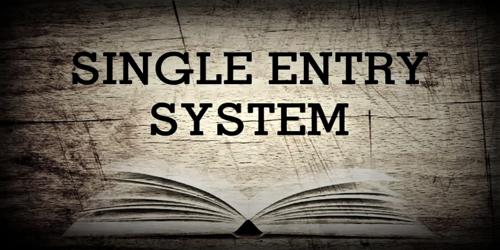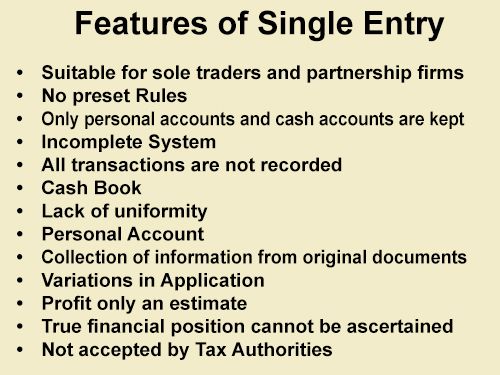 | |
|
Accounting records that are not maintained according to the
Double Entry System are known as Accounts from Incomplete Records or Single
Entry System of Accounting. It is an incomplete double entry system varying
with circumstances.
Key Points:
· Incomplete Records: It is a system of recording business transactions. In some of the transactions, both aspects are recorded; while in other on aspect is recorded or it is not recorded at all.
· Statements of Affairs: It is a statement of Assets and Liabilities. The difference between the two sides represents the proprietor’s (owner) capital.
· Capital: Amount invested by the owner.
· Drawings: Money or goods taken by the proprietor from the business for his/her personal use.
· Incomplete Records: It is a system of recording business transactions. In some of the transactions, both aspects are recorded; while in other on aspect is recorded or it is not recorded at all.
· Statements of Affairs: It is a statement of Assets and Liabilities. The difference between the two sides represents the proprietor’s (owner) capital.
· Capital: Amount invested by the owner.
· Drawings: Money or goods taken by the proprietor from the business for his/her personal use.

Ascertaining Profit under the Single Entry System:
1. Statements of Affairs Method
2. Conversion method
Net Worth Method or Statement of Affairs
Method
A Statements of Affairs is a statement of
assets and liabilities. Difference between the amounts of the two sides is
taken as capital method. Under the Single Entry System, it is necessary to
prepare Statements of Affairs at the
end of the year and also in the beginning of the year, if not already prepared
to determine profit. However, following two adjustments must be borne in mind
for determining profit:
·
Adjustment
for Capital Introduced: If the proprietor bought in additional capital
during the year, it should be deducted from the capital at the end (since this
increase is not due to profit but fresh introduction of capital).
·
Adjustments
for drawings: Drawings by the proprietor should be added to the capital at
the end and had the drawings not been made, the capital at the close of the
year would have been higher.
Formula for determining the profit is as
follows:
Profit = Capital at the end + Drawings – Additional Capital Introduced –
Capital in the beginning.
The above
formula may be shown as follows in the form of Statement of Profit or Loss:
Statement of Profit or Loss
For the year ended…
Example1: Akansha maintains books on
Single Entry System. She gives you the following information:
|
Particulars
|
Amount (Rs.)
|
|
Capital at the end
Add:
Drawings during the year
Less: Additional
Capital Introduced during the year
Adjusted capital at
the end
Less:
Capital in the beginning
Profit or Loss for the year
|
xxx
xxx
|
|
xxx
xxx
|
|
|
xxx
xxx
|
|
|
xxx
|
Capital on 1st April, 2018 Rs. 30,400
Capital on 1st April, 2019 Rs. 33,800
Drawings made during the period: April, 2018 to
March,2019 Rs. 9,600
Capital introduced on 1st August,2018 Rs. 4,000
You are
required to calculate the profit or loss made by Akansha.
Statement of Profit or Loss
For the year ended 31st
March,2019
Example2: Calculate the amount of profit or loss of Mr. X:
|
Particulars
|
Amount (Rs.)
|
|
Capital as on 1st
April, 2019
Add:
Drawings during the year: April,2018 to March,2019
Less:
Capital Introduced on 1st August,2018
Adjusted capital on
1st April,2019
Less:
Capital on 1st April,2018
Profit made during the year
|
33,800
9,600
|
|
43,400
4,000
|
|
|
39,400
30,400
|
|
|
9,000
|
Example2: Calculate the amount of profit or loss of Mr. X:
|
Particulars
|
Amount (Rs.)
1st Jan,2018
|
Amount (Rs.)
31st Dec,2018
|
|
Cash
Bank
Furniture
Creditor
Outstanding
Expenses
Stock
|
10,000
5,000
50,000
10,000
5,000
13,000
|
25,000
30,000
7,000
13,000
7,000
52,000
|
Solution:
Statement of Profit or Loss
For the year ended 31st Dec, 2018
Working
notes:
|
Particulars
|
Amount (Rs.)
|
|
Closing capital
Opening capital
Drawings
|
94,000
(63,000)
40,000
|
|
Net Profit
|
71,000
|
Statement of Affairs as at 31st Dec, 2018
Balance Sheet as on 31st Dec, 2018
|
Liabilities
|
Amount
(Rs.)
|
Assets
|
Amount
(Rs.)
|
|
Capital (b/f)
Creditor
Outstanding expenses
|
94,000
13,000
7,000
|
Cash
Bank
Furniture
Stock
|
25,000
30,000
7,000
52,000
|
|
|
1,14,000
|
|
1,14,000
|
|
Liabilities
|
Amount
(Rs.)
|
Assets
|
Amount
(Rs.)
|
|
Capital (b/f)
Creditor
|
63,000
10,000
|
Cash
Bank
Furniture
Stock
|
10,000
5,000
50,000
13,000
|
|
|
73,000
|
|
73,000
|
Informative.
ReplyDeleteInformative content
ReplyDelete